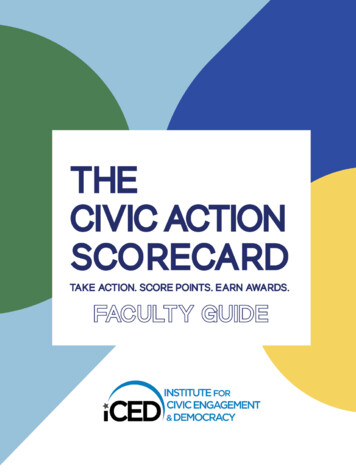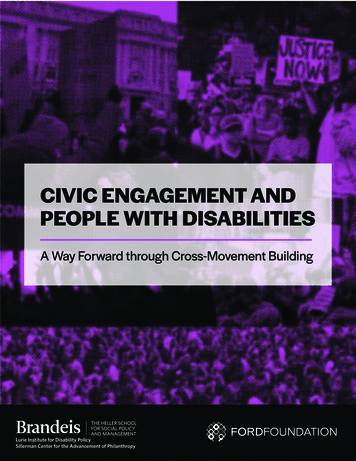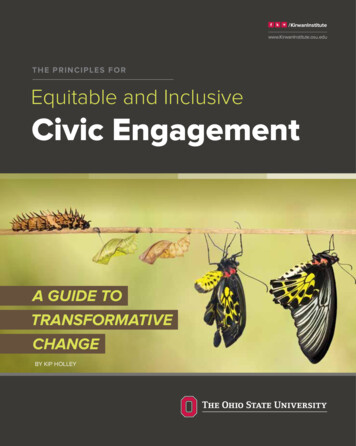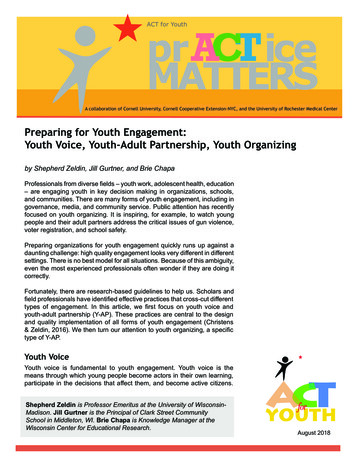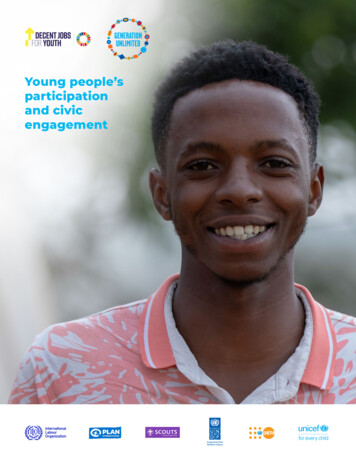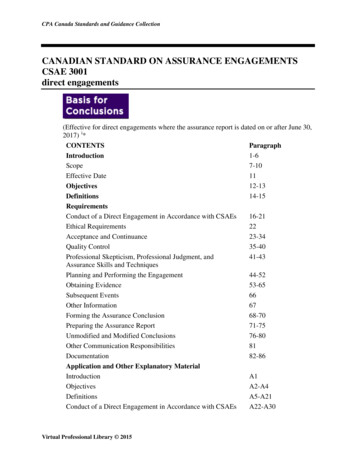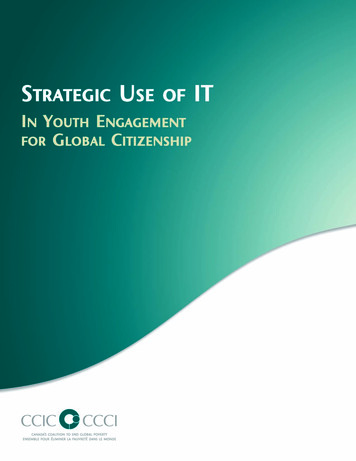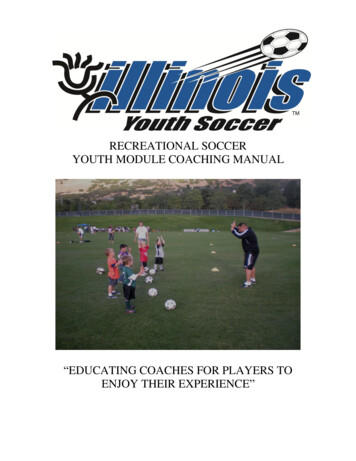
Transcription
YOUTH CIVIC EDUCATION,ENGAGEMENT, AND LEADERSHIPDEVELOPMENTGLOBAL LANDSCAPE ANALYSISMARCH 2021This publication was produced at the request of the United States Agency for International Development(USAID). It was independently prepared by Diana Haber, Masters Candidate at Tufts University’s FletcherSchool of Law and Diplomacy.
On the cover: The Young African Leadership Initiative (YALI) encourages alumni to serve their communities, bea positive influence for transformational change, and advocate for inclusive socio-economic growth. Participantsare civically engaged young leaders who serve the public through non-governmental organizations, communitybased organizations, or volunteerism. Following graduation at the Regional Leadership Centers, 90 percent ofalumni reported that they significantly improved their roles in community work and in civic engagement.Firehiwot Tadese (center) says that YALI made her think beyond her community and her country. She is nowmore motivated and engaged to fight for the inclusion of persons living with disabilities not only in Ethiopia andAfrica, but also globally. The YALI model provides promising practices for other regional youth networks.Credit: USAID/YALIUSAID.GOVYOUTH CIVIC EDUCATION, ENGAGEMENT, AND LEADERSHIP DEVELOPMENT GLOBAL LANDSCAPE ANALYSIS ii
TABLE OF CONTENTSACRONYMS . iiSUMMARY .1THE CIVIC IMPERATIVE .2KEY DEFINITIONS AND CONCEPTS.3PROMISING PRACTICES FOR FUTURE PROGRAM DESIGN .4Theory of Change .6Civic Education .8Civic and Political Engagement . 12THE EVOLVING DIGITAL CIVIC EDUCATION & ENGAGEMENT SPACE . 15Sample Digital Programs and Program Elements. 16Guiding Elements for Meaningful Youth Civic Education and Engagement . 17RECOMMENDATIONS FOR FUTURE PROGRAMMING . 18FURTHER RESEARCH TO EXPLORE . 19ANNEX: PROMISING PRACTICES . 20USAID.GOVYOUTH CIVIC EDUCATION, ENGAGEMENT, AND LEADERSHIP DEVELOPMENT i
ACRONYMSFCYOFunders’ Collaborative on Youth OrganizingGlobal LEADGlobal Leadership and Education for Advancing Development InitiativeICCSInternational Civic and Citizenship Education StudyMELMonitoring, Evaluation, and LearningMTMomavlis TaobaPYDPositive Youth DevelopmentYALIYoung African Leadership InitiativeUSAID.GOVYOUTH CIVIC EDUCATION, ENGAGEMENT, AND LEADERSHIP DEVELOPMENT ii
SUMMARYThe goal of this report is to support the development of innovative youth programs for the capacity andcommitment of young leaders to become partners in building self-reliant communities. It supportsUSAID’s new Global Leadership and Education for Advancing Development Initiative (Global LEAD),which seeks to activate 1 million young change-makers through USAID-funded activities in civiceducation, engagement, and leadership across sectors.Recognizing there are contextual civil society differences across regions and within countries, andhonoring the diversity of youth, this global overview seeks to understand recent patterns and trends.Clarity of current youth civic education and engagement related activities and patterns will enableUSAID to:1. Understand what youth civic education and engagement programming is happening acrossUSAID and other development spaces;2. Identify illustrative activities, indicators, and promising practices that increase the effectiveness,scale, and sustainability of youth civic education, engagement, and leadership development;3. Share how current research on the contribution of youth civic education, engagement, andleadership development applies across the breadth and depth of development outcomes; and4. Inform future USAID youth civic education, engagement, and leadership developmentprogramming with recommendations, and determine where potential innovations andpartnerships exist.On Leadership DevelopmentThis report primarily focuses on civic education and engagement opportunities. Understanding thatleadership development is an interconnected ongoing development outcome, civic education andengagement are considered tools for advancing youth’s leadership capacities. Additionally, a forthcomingguide on best practices, illustrative models, and lessons learned for supporting youth leadershipprograms and establishing, scaling, and sustaining a youth network across regional contexts willaccompany this report.MethodologyThis analysis was primarily based on document reviews and interviews with key informants to bolsterthe USAID evidence base since the 2002 USAID Democracy, Rights, and Governance publication,Approaches to Civic Education. Careful consideration was given to evidence-based activities andliterature with diverse geographic representation. Through an iterative data collection process, adatabase was created to analyze and code youth civic education, engagement, and leadershipdevelopment activities.USAID.GOVYOUTH CIVIC EDUCATION, ENGAGEMENT, AND LEADERSHIP DEVELOPMENT 1
THE CIVIC IMPERATIVECurrently, there are 1.2 billion young people (aged 10-29) worldwide1—the largest, most educatedcohort ever recorded. Youth today have tremendous access, creative energy, and motivation to connectacross diverse spaces. When this underrepresented cohort becomes engaged, the potential for progressin resilience, peace and security, and citizen responsive governance is magnified.The decisions and consequences that leaders make now will be experienced longest by young people.There is an increasing sense of urgency to engage youth as meaningful stakeholders. Significantfrustration can arise when youth are excluded in formal decision-making spaces. If not addressed, thesefeelings can lead to a loss of trust in democratic governance and can increase in conflict dynamics.Today, 125 million youth live in areas affected by armed conflict.2 By not effectively engaging youth,development actors leave low-cost potential development outcomes unrealized across the health,education, peace and security, and economic mobility sectors.FIGURE 1. THE CIVIC IMPERATIVESOURCE: UNITED NATIONSEarly engagement of young people in volunteering, civic action, and voting can lead to a “democraticdividend.” Research shows that engagement in early years can foster higher engagement levels in voting,volunteering, and civic participation throughout the life cycle.3USAID has long recognized that youth are at the forefront of global, social, economic, and politicaldevelopments. Currently, we see that youth are often the driving forces behind reform movements.They can quickly mobilize to participate in informal political spaces such as protests and advocacycampaigns, but are less engaged in formal political processes due to structural exclusions of them. As aresult, young people feel that civic engagement spaces are not accessible to them and, thus, they willinherit an inequitable democracy.“EduView Dashboard,” UNICEF, accessed May 14, 2020, n-dashboard/.Ibid3 Kathleen Hall Jamieson, Peter Levine, Ted McConnell, David B. Smith, eds., Guardian of Democracy: The Civic Mission ofSchools. (Rep. Philadelphia: Leonore Annenberg Institute for Civics of the Annenberg Public Policy Center at the University ofPennsylvania, 2011), https://media.carnegie.org/filer cny grantee 2011 guardian.pdf.12USAID.GOVYOUTH CIVIC EDUCATION, ENGAGEMENT, AND LEADERSHIP DEVELOPMENT 2
USAID’s civic learning and civic opportunities have been critical for promoting civic equality and equity: In Afghanistan, the USAID Promote: Women in Government program enrolled 3,901 femalehigh school and university graduates in three-month internship practicums across 80government ministries and independent agencies and worked with the Government ofAfghanistan to encourage inclusive policy reforms that empower young women working in thegovernment. The program also implemented innovative, nationwide communications andadvocacy campaigns to expand the impact of project interventions and promote localstakeholder support for professional women. In Kosovo, the Up to Youth program established a diverse Youth Advisory Board, whichengaged more than 2,900 youth in Up to Youth’s community outreach activities. Up to Youthmobilized more than 450 youth throughout nine partner municipalities to improve theircapacities and skills for contributing to and benefitting from better communities and livelihoods. In Guatemala, the Proyecto Acción Transformadora program is mobilizing 5,000 young leadersacross 17 municipalities to participate actively in political spaces. By strengthening youth-ledorganizations, groups, and networks, the young leaders will positively influence youth policy,inequality, security, migration, and governance in their communities and at the national level.The progress of our societies, especially as we respond to the global COVID-19 pandemic, is based oneach society’s capacity to co-create with youth in building and advance a resilient, peaceful, and secure,citizen-responsive future.KEY DEFINITIONS AND CONCEPTSCivic Education: Formal and non-formal activities that promote knowledge, attitudes, values, skills, andbehaviors desired of citizens to increase political participation and civic engagement.4Civic Engagement/Participation: Active participation of young people in age-appropriate activities thatadvance social, civic, and political outcomes.Youth Leadership Development: The process of supporting youth to inspire and mobilize others for acommon purpose or to personal and/or social issues and challenges in order to effect positive change.Equity and Inclusive Development: The principle that every person, regardless of identity, is instrumentalin the transformation of their own communities, and their inclusion throughout the developmentprocess leads to better outcomes.5Positive Youth Development: The Positive Youth Development (PYD) approach engages youth alongwith their families, communities, and/or governments so that youth are empowered to reach their full“Youth Inclusion DRG Toolkit Glossary”, YouthPower, accessed March 2, 2021, kit-glossary.5 Anthony Cotton, Suggested Approaches for Integrating Inclusive Development Across the Program Cycle and in MissionOperations, (USAID, 2018), 29.4USAID.GOVYOUTH CIVIC EDUCATION, ENGAGEMENT, AND LEADERSHIP DEVELOPMENT 3
potential. PYD approaches build skills, assets, andcompetencies; foster healthy relationships;strengthen the environment; and transformsystems.FIGURE 2. CIVIC EDUCATION: ELEMENTS ANDEXAMPLESSoft Skills/Life Skills: A “broad set of skills,competencies, behaviors, and attitudes thatenable people to effectively navigate theirenvironment, work well with others, and achievetheir goals.”6 When youth and adults develop andcultivate these interconnected sets of positivecompetencies and skills, communities are betterequipped to holistically promote sustainable socialoutcomes.7Project-Based and Service Learning: An“authentic, experiential form of learning centeredaround the collaborative investigation andresolution of real-world problems,”8 wherelearners and teachers are viewed as leaders.9 (SeeTalloires Network for University-based model)SOURCE: YOUTHPOWERPROMISING PRACTICES FOR FUTURE PROGRAM DESIGNVisualizing the Continuum for Youth Civic Education, Engagement, and Leadership DevelopmentThe Youth Engagement Continuum describes both forms and degrees of youth engagement on adevelopmental path that progresses toward authentic youth empowerment in education, civic, andpolitical participation and decision-making. Figure 3 visualizes power-sharing between adult and youthdecision-makers, and is adapted from the Funders’ Collaborative on Youth Organizing (FCYO).Laura Lippman, Renee Ryberg, Rachel Carney, Kristin Anderson Moore, Key “Soft Skills” that Foster Youth WorkforceSuccess: Toward a Consensus Across Fields, (Washington, DC: USAID, FHI 360, Child Trends, 2015).6“From a Nation at Risk to a Nation at Hope”, The Aspen Institute National Commission on Social, Emotional, & AcademicDevelopment, accessed March 2, 2021, http://nationathope.org/report-from-the-nation.8 Linda Torp and Sara Sage, Problems as possibilities: Problem-based learning for K-12 education, ASCD, ties.aspx.9 Barbara King and Carmen Smith, “Using Project-Based Learning to Develop Teachers for Leadership,” The Clearing House: AJournal of Educational Strategies, Issues and Ideas 93, no. 3 (2020): 158-64.7USAID.GOVYOUTH CIVIC EDUCATION, ENGAGEMENT, AND LEADERSHIP DEVELOPMENT 4
FIGURE 3. POSITIVE YOUTH DEVELOPMENT CONTINUUM FOR YOUTH CIVIC ENGAGEMENT ANDLEADERSHIP DEVELOPMENTInfluencing Change Across Socio-Ecological SystemsUSAID uses the socio-ecological systems model10 in all PYDprogramming to provide a framework for understanding theinfluences on youth knowledge, attitudes, and behaviors andhow interventions contribute to shaping behavior. Frequentand cumulative exposure to youth civic programming is oneof the key elements in ensuring its effectiveness.FIGURE 4. SOCIO-ECOLOGICAL SYSTEMSFRAMEWORKWhen resources and interventions are in place across thesystems levels, with a system-wide understanding of theirappropriate roles in local dynamics and contexts, youngpeople can be better positioned for meaningful engagementin their communities.10Urie Bronfenbrenner, “Ecological systems theory”, (Jessica Kingsley Publishers,1992).USAID.GOVYOUTH CIVIC EDUCATION, ENGAGEMENT, AND LEADERSHIP DEVELOPMENT 5
THEORY OF CHANGEGrounded in the PYD approach, the sample theory of change below identifies the following connectedset of illustrative practices to activate and support young change-makers as part of the USAID GlobalLEAD initiative. These design components collectively represent the change streams of sampleobjectives and intermediate results for achieving the intended goal.FIGURE 5. SAMPLE THEORY OF CHANGE FOR PYD CIVIC EDUCATION, ENGAGEMENT AND LEADERSHIPDEVELOPMENTNARRATIVE SUMMARYThe theory of change says: If youth have access to quality participatory civic education, civic engagement, and leadershiptraining opportunities; and If youth have positive adult relationships with teachers/instructors, community leaders, andemployers who have skills training and support to apply the positive youth developmentapproach to their practice; and If youth have an enabling environment to meaningfully engage via inter-ministerial coordination,community organizations, public and private partners, and decision-makers efforts; Then youth assets, agency, and contribution will increase, and communities will improve supportfor youth-led initiatives for the promotion and adoption of sustainable social outcomes.USAID.GOVYOUTH CIVIC EDUCATION, ENGAGEMENT, AND LEADERSHIP DEVELOPMENT 6
This theory of change is based on the following key assumptions: Organizational capacity of decision-makers to respond to youth’s needs, and USAID can providetechnical assistance for priority areas. USAID and its partners make intentional efforts for promoting equitable participation fordiverse youth engagement, inclusion and belonging, and reducing barriers to access formarginalized youth. USAID and its partners have safe access to working with schools, communities, employers, andpolicy/decision-makers. Formal and non-formal education spaces are considered and the quality level remains the samefor teachers/instructors, community leaders, and employers. Additional contributing factors for ensuring youth’s peace and security are being addressed byUSAID’s current work with young leaders, higher education institutions, and other sectoralpartners.The outlined theory of change seeks to bolster the design, monitoring, and evaluation of programs thatadequately address the following barriers: Limited context-relevant and conflict-sensitive pedagogy to teach and sustain civic educationthrough participatory learning. Limited opportunities for relevant civic engagement in communities; limited linkages to the nextprogression for activities that reflect youth’s interests and support by their social networks. Limited opportunities to connect youth-led initiatives and youth engagement from thegrassroots level to formal decision-making spaces for programming, policy, and budget priorities. Limited access to and knowledge of formal democratic and electoral processes.USAID.GOVYOUTH CIVIC EDUCATION, ENGAGEMENT, AND LEADERSHIP DEVELOPMENT 7
CIVIC EDUCATIONCURRENT REVIEW OF YOUTH CIVIC EDUCATIONIn many contexts, schools remain the central institution thatengage youth. Therefore, schools have a role in developing thefoundational knowledge, beliefs, and behaviors needed to closethe gap between ability and opportunity for civic engagement.11Schools also serve as a bridge for connecting across multigenerations and diverse populations, which can help to breakdown negative stereotypes and foster trust and cohesion. Thatsaid, the impact of COVID-19 demonstrates that education canexist beyond the classroom and in blended learning settings.A civic education curriculum thatenhances critical consciousness iscrucial for overcoming inequities byallowing youth to contextualize theirlived experiences, “building a sense ofagency and motivation to change thesystems that have affected them.”-Generation CitizenThe quality of facilitation on civic education by instructors is essential. Research shows that whenteachers use interactive and participatory teaching methods such as role-playing, debates, mock trials,and simulations, students further develop civic dispositions such as tolerance and the ability to expresstheir opinions on issues.12Many education systems have institutionalized civic education curricula across primary, secondary, andtertiary levels. In some cases, civic education is exclusively delivered through non-governmental and civilsociety organizations, resulting in repetitive participation by the same group of young people. Youth whoare not participating do not have either enrollment awareness or access.13 In this respect, programmingcan risk perpetuating or exacerbating the inequalities in political participation.Moreover, conditions of education systems have an influence on interventions. Tensions may existbetween curriculum and pedagogical practices of community programming and formal classrooms, whichcould set back students’ progress and continued exposure in civic education. Programs such as YouthDemocracy Camps work to overcome this by inviting formal educators to observe, network, and learnfrom the camps’ facilitators.DIGITAL CIVIC EDUCATIONThe evolving digital realm for civic education to amplify student voice and agency14 is specificallyhighlighted later in this report.Rebecca Winthrop, “The Need for Civic Education in 21st-Century Schools.” Brookings (blog), June 4, ols/.12 Steven Finkel and Howard R. Ernst, “Civic Education in Post‐Apartheid South Africa: Alternative Paths to the Developmentof Political Knowledge and Democratic Values” Political Psychology, Volume 26, Issue 3 (May 2005): 333-364.13 Liana Sargsyan, interviewed by Diana Haber and Anna Cron, August 3, 2020.14 Amy Chapman, Christine Greenhow, Kyle Greenwalt, Douglas Hartman, and Rand Spiro, “Meeting Them Where They Are:The Use of Twitter in Youth Civic Education”, (PQDT-Global, 2019).11USAID.GOVYOUTH CIVIC EDUCATION, ENGAGEMENT, AND LEADERSHIP DEVELOPMENT 8
Illustrative Activities for Youth Civic Education Across Socio-Ecological LevelsAnalysis of past and current USAID projects identify the following activities for addressing high-levelcommon barriers to civic education, both in formal classroom and community-based spaces.TABLE 1. ILLUSTRATIVE EXAMPLES ACROSS THE SOCIO-ECOLOGICAL MODELADDRESSING COMMONBARRIERS THROUGHCIVIC EDUCATIONLimited access to andknowledge of formaldemocratic and electoralprocessesLow capacity for youth totrust elections as a way toexpress their concerns,demand change, and holdleaders accountableWeak curriculum and skillsin education systems toalign for civic participationand employment/labormarket expectations15ILLUSTRATIVE yand gamifiedlearningSupport civicbeliefs:differingperspectives,free copportunities to exercisecompetencies to vote,volunteer,debate, andattend TEMSPeer engagementto practice softskills18Safe spaceopportunitiesfor participation(vocationaltraining, sports,arts, debate,youth centers)Collaborate with thegovernment departmentresponsible forinstitutionalizing civic educationcurriculumFamily members toconnect skillbuilding and civiceducation activitiesEducate parents onsoft skills for youthand provideparental support tobuild these skillsEncourage adultmodeling of soft /life skillsIntegrate softskills intoeducational,vocational,extra-curricular,and erismlearning projectsSupport voter educationefforts to reach and activateyouth from diversecommunities and encouragetheir participation in electionsIncrease funding to expandcivic education curriculum andencourage extra-curricularactivities (with schools, youthcenters etc.)Include youth in the research,design, and feedback of civiceducation curriculumSupportprofessionaldevelopment ofteachers andfacilitatorsGeneration Citizen, The Talloires Network for Service Learning, iCivics, Project CitizenTABLE 2. ILLUSTRATIVE CIVIC EDUCATION MODELSPROGRAM HIGHLIGHT: ANA USHAREKPYD Alignment:Assets,Contribution, &Safe Space/ EnablingEnvironmentThe Ana Usharek (I Participate) and Usharek programs, both supported by USAID and implementedby the National Democratic Institute, have engaged more than 30,000 youth in constructive dialogueson important public policy issues with decision-makers and members of parliament in roundtable andtown hall meetings. Youth visit local organizations to discuss these issues and reform measures. Semester-long extracurricular program that allows youth to “learn by doing” through debatecompetitions and implemented more than 50 grassroots advocacy campaigns Video on both Ana Usharek and Usharek program models available“Youth Civic Engagement: Enabling Youth Participation in Political, Social and Economic Life”, UNESCO, last modified June,2014.15USAID.GOVYOUTH CIVIC EDUCATION, ENGAGEMENT, AND LEADERSHIP DEVELOPMENT 9
PROGRAM HIGHLIGHT: ANA USHAREK Youth, including young women, are seen as leaders and encouraged to take on leadershiproles. Youth are given leadership roles as program staff designing training curricula, leadingdiscussion sessions, and other activitiesEXPERT HIGHLIGHT: THE INTERNATIONAL CIVIC AND CITIZENSHIP EDUCATION STUDYResearch andAssessmentSpotlightThe International Civic and Citizenship Education Study (ICCS) investigates the ways in which youngpeople are prepared to undertake their roles as citizens. It is directed by the International Associationfor the Evaluation of Educational Achievement. Utilizes a rigorous framework of qualitative and quantitative assessments to identify andmonitor students’ knowledge, attitudes, and activities related to civic and citizenshipeducation Grounded in core themes in civic and citizenship education such as young people’sunderstanding of civic principles and institutions, their knowledge of how to engage in civilsociety, and exercise critical judgment, and their understanding and appreciation of the rightsand responsibilities Can support monitoring progress for civic education’s proof of efficacyEXPERT HIGHLIGHT: THE TALLOIRES NETWORKHigher EducationSpotlightUSAID.GOVThe Talloires Network is a coalition of 379 universities in 77 countries contributing to the globaluniversity civic engagement movement. Designed to raise the standards of civic engagement practice inhigher education through the following sample activities: Student seminars and exchanges Regional and international conferences Faculty and staff development workshops University-community sessions in fostering trust and cohesion Grants to encourage and support innovative practicesYOUTH CIVIC EDUCATION, ENGAGEMENT, AND LEADERSHIP DEVELOPMENT 10
CIVIC EDUCATION METRICSUSAID prioritizes the following indicators, both standard and custom, for data collection and impactmeasurement. The USAID-funded YouthPower platform provides additional illustrative indicators.16FIGURE 6. CIVIC EDUCATION METRICSILLUSTRATIVE IMPACT EVALUATIONMomavlis Taoba Civic Education Initiative by USAID/Georgia is a recent example of utilizing Standard Fand illustrative indicators to test civic education outcomes and impacts. The project aims toinstitutionalize secondary school civic education activities in 240 schools to promote greater youth civicengagement.FIGURE 7. THE GEORGIA CIVIC EDUCATION INITIATIVE: MOMAVLIS TAOBA (MT) (2014-2019)Laura Hinson, Heather Marlow, and Cassandra Jessee, “Evidence and Promising Practices from Peer-Based Approaches inYouth Programs”, YouthPower, (Making Cents International, 2020), grams.16USAID.GOVYOUTH CIVIC EDUCATION, ENGAGEMENT, AND LEADERSHIP DEVELOPMENT 11
CIVIC AND POLITICAL ENGAGEMENTCURRENT REVIEW OF YOUTH CIVIC ENGAGEMENTGlobally, there is an increase in the number of and the intensity ofyouth-led social movements. These demonstrations of non-violentcivil action are increasingly motivated by both specific nationalissues17 and transnational issues such as environmental, racialjustice, and rights-based movements. However, today’s civilresistance demonstrations are less likely to result in systemschange than those in the early 21st century.18There is also a shift in the collective organization and solidarity amongst these movements. For example,in the Middle East and North Africa region, multigenerational protests are often now more unified andsecular than those in 2010 In Colombia, youth, indigenous groups, and labor unions formed one voicedemonstrating against inequality and corruption. In Belarus, pro-democracy demonstrations unifiedacross generations and socioeconomic classes in response to the 2020 presidential elections.This trend may be a result of: Increased access to digital information, leading to a rising awareness of inequities Mistrust in elections and elected officials by youth and, in turn, the false perceptions of youngpeople and their capabilities by adults (young women may face a “double discrimination” basedon age and gender) Structural exclusions and a lack of a clear pathway of citizen participation including requirementsof high voting age and candidacy eligibility Temporal elements–youth do not tend to see the impacts of slow progress and are advocatingfor policy change on an accelerated timetable19 Youth-led social movements that are met with resistance from governance can lead to a furtherdivide between the responsibility of individual citizens and the power of the state20Young people are acknowledging that advocacy and civic engagement stretch beyond socialdemonstrations to influence change. Civic engagement opportunities are critical for youth developmentto teach essential communication skills so they can articulate their needs and work to generate systemicchange through effective channels.21 Livelihoods are also a primary concern for today’s educated youthand are major drivers behind social demonstrations. Participating in civil society can develop necessaryskills and competencies for youth to strengthen their networks and discover job opportunities.22Zachary Jason, “Student Activisum 2.0”, Harvard Ed. Magazine, Fall dent-activism-20.18 Richard Youngs, Youssef Cherif, Hafsa Halawa, Vijayan Mj, Adams Oloo, Natalia Shapovalova, Janjira Sombatpoonsiri, MarisaVon Bülow, and Özge Zihnioğlu, “Global Civic Activism in Flux,” Carnegie Endowment For International Peace (March 2017): 2.19 Aryn Baker, “A New Generation of Leaders Inspired By Activist Movements Is Driv
political participation and decision-making. Figure 3 visualizes power-sharing between adult and youth decision-makers, and is adapted from the Funders' Collaborative on Youth Organizing (FCYO). 6 Laura Lippman, Renee Ryberg, Rachel Carney, Kristin Anderson Moore, Key "Soft Skills" that Foster Youth Workforce
